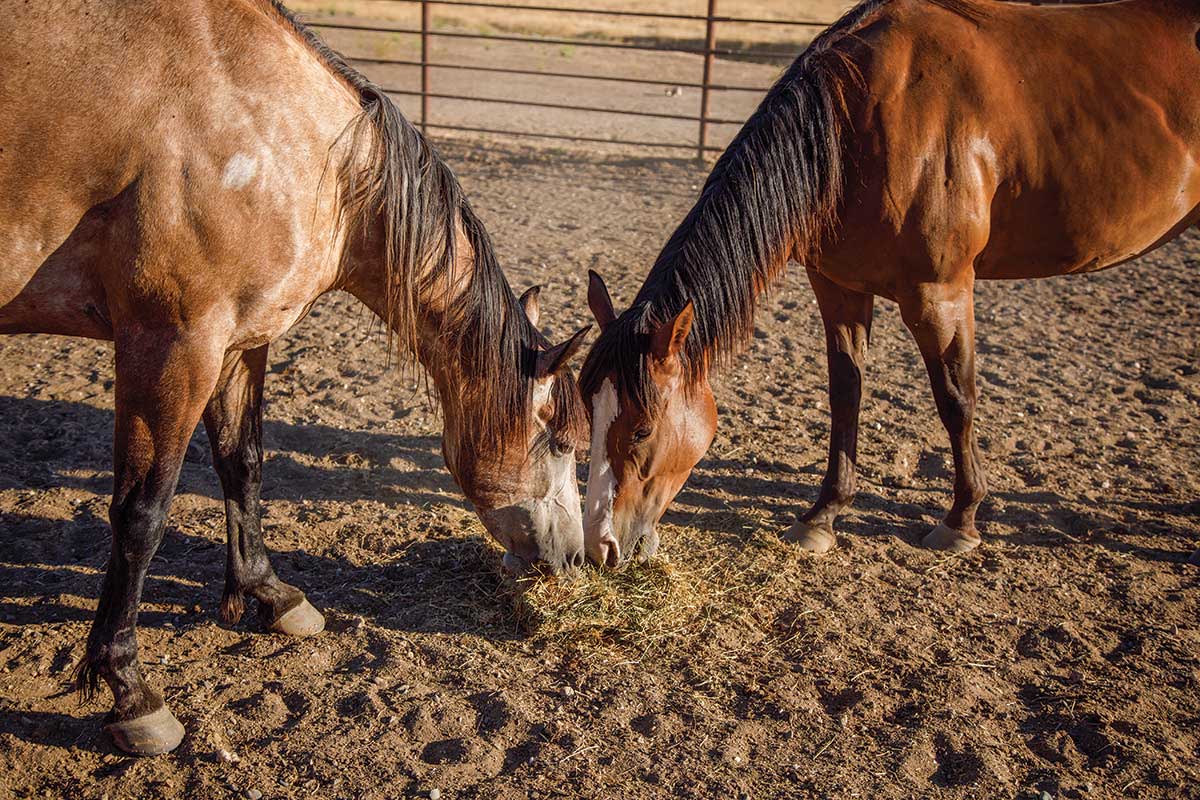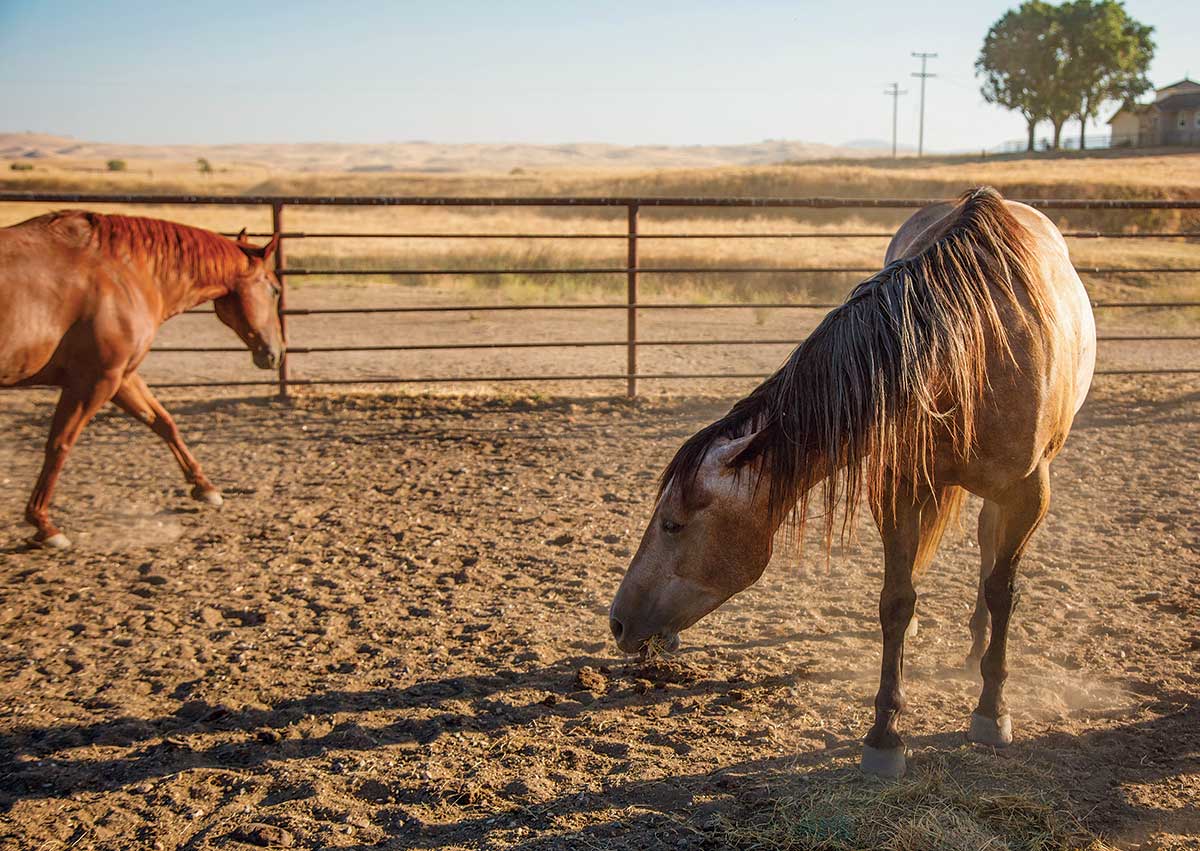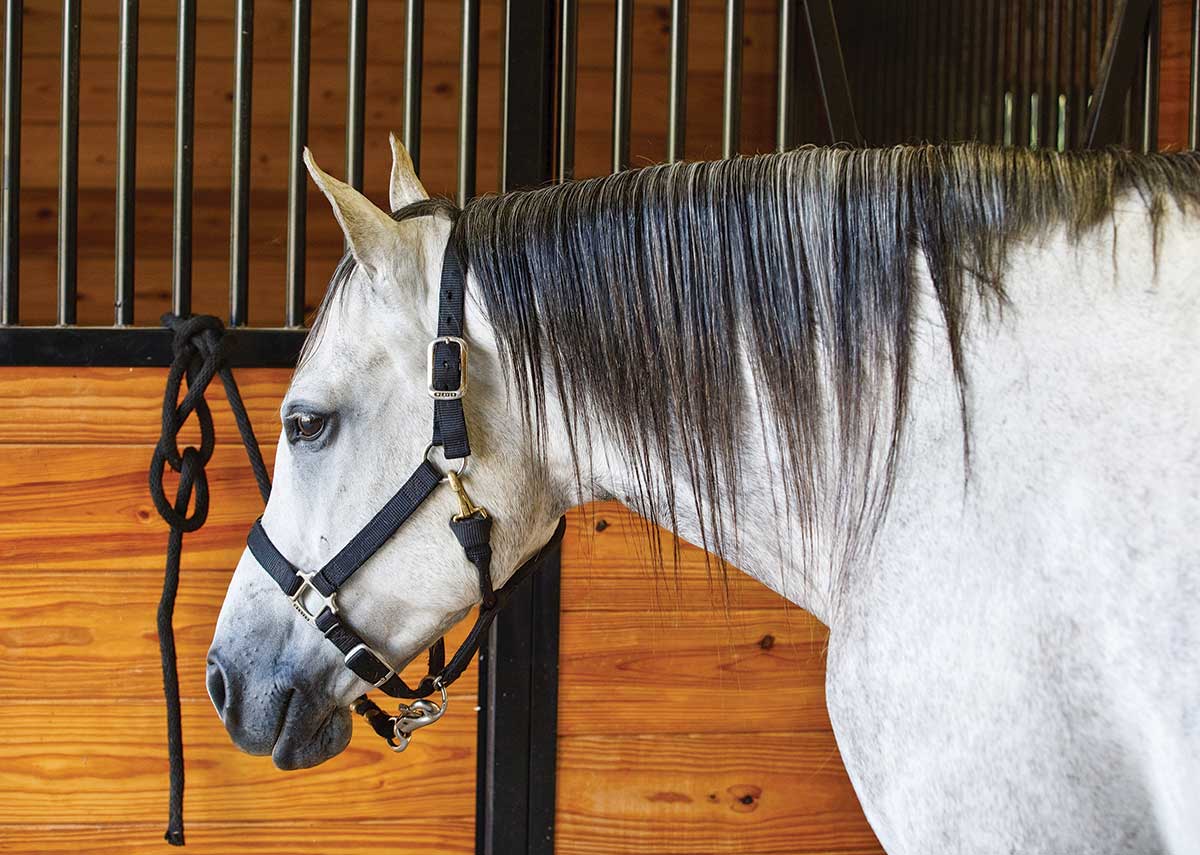
Food sustains all living creatures. As a result, it’s a highly motivating factor in many species’ behavior, including horses. Getting enough to eat is critical to horses’ physical and mental well-being. When horses live in a group, basic equine behaviors and the personalities of individual horses can complicate the eating process, causing disharmony, stress, and physical issues ranging from undernourishment to battle wounds. Here, we examine the concerns that may arise when you feed horses in a group, and how to resolve them.
[READ: 14 Safety Rules for Horses]
Nature’s Way
In the wild, horses spend about 60 percent of their time foraging or grazing. Squabbles among groups of wild horses rarely arise over grass, as it’s usually dispersed enough that each herd member gets a chance to eat. If there’s too little grass, the group moves on. Horses can cover dozens of miles in a day as they seek to keep all herd members fed.
Water, however, is more likely to be a source of skirmishes among wild horses, because it’s usually more limited. The natural order for the herd at the water hole puts the stallion first, mares next, and juveniles last.
Does this shed light on how domestic horses behave in a group at feeding time? Yes—it seems to indicate that as long as food is plentiful, horses can, in theory, eat together peacefully. But if a resource (food or water) is limited, a hierarchy emerges. With domestic horses, of course, hierarchies typically don’t include a stallion, and we find that dominance behaviors tend to stem more from the horses’ individual personalities than from their sex or age.

Aggression’s Roots
Why do some horses become aggressive when food enters a scenario? Food is critical to life, yes, but how do horses rank it against other things important to them—such as freedom, companionship, and even a hardwired vice?
I worked on a series of experiments at Cornell University that showed just where food ranks for horses. We used operant conditioning (the horse learned to press a button with his nose to get what he wanted) to test horses’ preferences. We wanted to see how important it would be to them to a) let themselves out of a tie stall and into a paddock after 23 hours of restraint; b) have contact with another horse; and c) be in a position to indulge a cribbing habit. Each of those desires was compared with the importance of food. The result? Food was found to be the most motivating force of them all.
Horses find food worthy of guarding from other horses, especially so if there isn’t enough to go around. Even hay will spark a fight if there isn’t enough of it. If feeding hay causes aggression (and especially if the horses are also chewing wood), it helps to increase the amount of hay provided. By contrast, grain or sweet feed in any amount is even more likely to cause tempers to flare and horses to enforce the pecking order with their teeth and hoofs.
Group Eating Is Good
It’s natural and healthy for horses to live together, and eating in a group has clear benefits. Research shows that horses eat better and longer if they can see another horse as they eat (as long as aggression doesn’t interfere).
At the University of California at Davis, researchers paired a dominant horse and a subordinate one in an enclosure and recorded the time each horse spent eating. With no barrier between the horses, the dominant one spent much more time eating than the subordinate did. When a solid barrier was placed between them so they couldn’t see each other, the dominant horse actually spent less time eating, while the subordinate one was able to spend more time eating than it had with no barrier.
But here’s the interesting part. When a wire barrier that the horses could see through was placed between them, both horses ate more than they had when they couldn’t see each other. Apparently, there is “social facilitation” of eating—that is, a horse will eat more when another horse is eating nearby, possibly because he feels safer.
As wild horses do, horses pastured on ample grass will graze about 60 percent of the time. Similarly, horses provided with free-choice hay on a dry lot will spend about that same percentage of their day eating the hay. Based on those statistics, it would be easy to assume that if you’re feeding horses individual portions on a schedule, then providing more frequent feedings throughout a day would be more soothing for them.
In tests, however, researchers found the opposite to be true. In other words, unwanted stereotypic behaviors (such as cribbing, weaving, and stall walking) increased when horses were fed three times a day rather than only once or twice a day. Why is this? The tests indicated that the mere anticipation of feeding time, which is in itself stressful to horses, contributes to anxious behavior, which in turn can lead to aggressive behavior. When feeding a group on a schedule, those anxieties or aggressions will arise to some degree in each group member.
By contrast, the ability to browse throughout the day—even when not taking in sustaining amounts of food—may help temper aggression. Searching for food is known as appetitive behavior and is soothing to horses. (Actually eating food is known as consummatory behavior.) Because horses get some satiety from appetitive behavior—that is, from simply being able to stroll about and nibble at the barest plant growth—this can reduce their inclination toward aggression.


Solving Spats
The easiest way to know if feeding time causes behavior problems in your own equine group is to watch carefully as you place the feed, then stay and observe as the horses eat. You’ll see which individuals threaten others and which hang back, fearful and hoping for a morsel. Other indicators of trouble are bite and kick wounds or weight loss in subordinate horses.
Again, with ample hay for all, horses should be able to eat peacefully as a group. To enhance the peace further, place feed in separate piles or in feeders situated at least 10 feet apart. Also, add an extra feeding station so that any horse intimidated away from his hay can easily find another station to go to. (For example, if you’re feeding five horses, provide six feeding stations.)
Grain or sweet feed, again, is far more likely to cause upheaval in the group. If all horses are receiving grain, arrange separate feeding stations, as with hay. If feeding grain to only one horse in a group, it’s best to remove that horse from the enclosure before offering or even handling the grain. Horses that sense grain is present may approach you, making it difficult for you to safely access just one horse. Once you’ve safely moved your horse out of the group, allow him ample time to eat peacefully in a separate enclosure or on a lead line.
[READ: Horseman’s Safety Test]
Key Group-Feeding Tips
Establish a feeding routine. Feed time raises horses’ anxieties, but when they know precisely what to expect from you, it helps alleviate anxiety and aggression. Be sure anyone else who feeds knows the routine, too.
Think things through and take your time at every feeding. Many accidents happen when people rush and take shortcuts.
If possible, feed from outside the horses’ enclosure. Your chances of being hurt are much higher if you’re in among hungry animals as they jostle for position.
Place piles of hay or feeders at least 10 feet apart, and always provide an extra (e.g., five piles of hay for four horses).
If you remove or tie aggressors or remove subordinates for feeding, do so well before offering feed, as the sound or scent of it can launch the unwanted behaviors.
A group’s aggressor (or aggressors—there can be more than one) can be tied if need be during feeding to enable the rest of group to eat in peace, especially for grain. Arrange tie stations ahead of time, with sturdy posts and safety-release mechanisms in case of an accident. Catch aggressors with carrots to help ease them into a routine of being tied during group feeding. Tie them so the lead is just long enough to allow them to reach their own feed.
If you’re lucky enough to be able to build or modify your enclosure, remember that the smaller the pen, the more likely you’ll have feeding-time skirmishes. Where possible, allow ample room for the number of horses to be suitably spread out during a meal (remember—10 feet apart at minimum). The shape of the enclosure matters, too. Rounded designs prevent dominant horses from running subordinate ones into corners and trapping them, and a square pen is better than a narrow rectangular pen for the same reason.
Taking the time to enhance your enclosure and making the extra effort to separate dominant from subordinate horses if need be will pay off by enabling the horses to eat in peace. As such feeding time will be safer for you, too.
Dr. Katherine Albro Houpt treats horses, dogs, and cats with behavior problems. In addition to being a veterinarian, Dr. Houpt holds a doctoral degree in behavioral biology, is board certified by the American College of Veterinary Behaviorists, and is professor emeritus at Cornell University’s College of Veterinary Medicine. She’s taught courses on equine, farm animal, and companion animal behavior, and mentored residents intending to specialize in veterinary behavior. Author of the textbook Domestic Animal Behavior, she’s also written numerous scientific articles.






